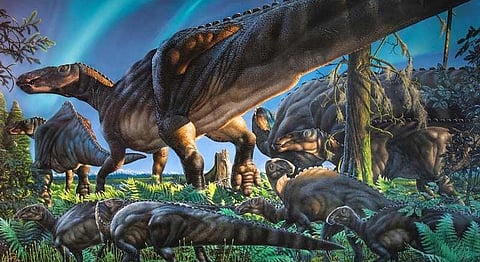
- #HGCREATORS
- #HGEXPLORE
- #HGVOICES
- #HGSHOP
- CAREERS
- ABOUT US
- CONTACT US

Winter was coming, and they didn't budge
Ugrunaaluk
kuukpikensis
"The finding of dinosaurs this far north challenges everything we thought about a dinosaur's physiology," said Greg Erickson, Professor of Biological Science at FSU. "It creates this natural question. How did they survive up here?"
According to the researchers, during the lifetime of these creatures, Arctic Alaska was covered with trees because Earth's climate was much warmer then. However, considering that it was so far north, the dinosaurs likely dealt with months of winter darkness, even if it wasn't as cold as a modern-day winter. They lived in a world where the average temperature was about 43 degrees Fahrenheit, and they probably saw snow.
"What we're finding is basically this lost world of dinosaurs with many new forms completely new to science," said Erickson. Since the 1980s, scientists from the University of Alaska Museum of the North, and other collaborative institutions, including Florida State University, have collected more than 9,000 bones from various animals as part of the excavation of the Prince Creek Formation.
The majority of the bones of the Ugrunaaluk kuukpikensis were collected from a single layer of rock called the Liscomb Bonebed. The layer, about 2 to 3 feet thick, contains thousands of bones of primarily this one species of dinosaur.
In this particular area, most of the skeletons are from younger or juvenile dinosaurs, about 9 feet long and three feet tall at the hip. Researchers believe a herd of juveniles was killed suddenly, creating this deposit of remains.
Hirotsugu Mori, a former graduate student at UAF, completed a detailed analysis of the bone structure as part of his doctoral dissertation alongside Druckenmiller and Erickson.
Their work revealed that the Ugrunaaluk kuukpikensis is most closely related to Edmontosaurus, another type of duck-billed dinosaur that lived roughly 70 million years ago in Alberta, Montana and South Dakota.
"Because many of the bones from our Alaskan species were from younger individuals, a challenge of this study was figuring out if the differences with other hadrosaurs was just because they were young, or if they were really a different species," Druckenmiller said. "Fortunately, we also had bones from older animals that helped us realize Ugrunaaluk was a totally new animal."
The inspection of the near-adult size remains made them realise that a combination of features found in these skeletons were not present in Edmontosaurus or in any other species of duck-billed dinosaurs.
In particular, it was the unique skeletal structures in the area of the skull, especially around the mouth, that sets the Ugrunaaluk kuukpikensis apart from the rest. They seemed to have "batteries" of 14,000 teeth that would help grind coarse greenery. They also believe that they had "Godzilla-like spikes" on the back, just for show.
Both, Erickson and Druckenmiller will continue to mine the Prince Creek Formation for additional skeletons. However, accessing the field site is extremely difficult. Besides the frigid weather, they have to use bush planes that are capable of landing on gravel bars and inflatable boats to access the sites, and often have to rappel down the side of a cliff to do the digging.
However, taking into consideration the fact that the area is rich with animal skeletons, which they estimate to be of at least 13 different species of dinosaur present based on teeth and other remains, plus birds, small mammals and some fish, we imagine that they are as excited as we are about the possibilities this space holds.
Through the course of investigation they will try and uncover the answers to the questions that are plaguing our minds--how did these animals live here? How did they survive in these conditions that were typically thought to be amenable to them?
"Alaska is basically the last frontier," said Erickson, who is originally from Alaska. "It's virtually unexplored in terms of vertebrate palaeontology. So we think we're going to find a lot of new species."
Three full skeletons of Ugrunaaluk kuukpikensis will be assembled for display at the University of Alaska Museum of the North along with a painting of the species by Alaskan artist James Havens. The discovery has also been described in detail in an issue of the palaeontology journal Acta Palaeontologica Polonica for those interested in learning more.






